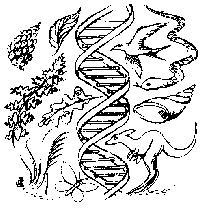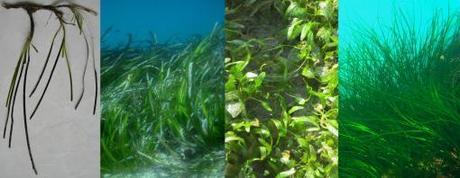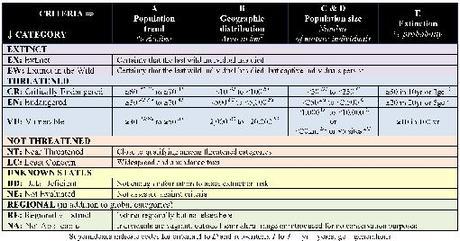
http://goo.gl/dG89x
The International Union for Conservation of Nature (IUCN) Red List of Threatened Species uses 6 quantitative criteria to allocate species to 9 categories of extinction risk. The criteria are based on ecological theory (1, 2), and are therefore subject to modification and critique. With pros and cons (3-6), and intrigues (7, 8), the list has established itself as an important tool for assessing the state of biodiversity globally and, more recently, regionally.
–
We all carry codes of some sort; that is, unique alphanumeric labels identifying our membership in a collectivity. Some of those codes (e.g., a videoclub customer number) make sense only locally, some do internationally (e.g., passport number). Species are also members of the club of biodiversity and, by virtue of our modern concern for their conservation, the status of many taxa has been allocated to alphanumeric categories under different rationales such as extinction risk or trading schemes (5, 9-13). Contradiction emerges when taxa might be threatened locally but not internationally, or vice versa.
In the journal Biological Conservation, a recent paper (14) has echoed the problem for the seagrass Zostera muelleri. This marine phanerogam occurs in Australia, New Zealand and Papua New Guinea, and is listed as “Least Concern” (LC) with “Stable” population trend by the IUCN. Matheson et al. (14) stated that such status neglects the “substantial loss” of seagrass habitats in New Zealand, and that the attribution of “prolific seed production” to the species reflects the IUCN assessment bias towards Australian populations. The IUCN Seagrass Red List Authority, Fred Short, responded (15) that IUCN species ratings indicate global status (i.e., not representative for individual countries) and that, based on available quantitative data and expert opinion, the declines of Z. muelleri are localised and offset by stable or expanding populations throughout its range.
Globalising the assessment of extinction risk
The IUCN Red List has the virtue of being quantitative and comprehensive, thus replicable. It is certainly superior over national threatened-species lists that are based on qualitative categories, e.g., the loosely defined “vulnerable” and “in risk of extinction” of the Spanish catalogue of endangered species. Some studies have recently compared extinction categories by the IUCN against the catalogues of endangered/protected species of several countries. Thus, an average of 20% of species regarded as threatened in Brazil, Colombia, China and the Philippines have not been assessed by the IUCN and, in turn, 14% of species threatened by IUCN standards have not been listed by those countries (16). The two scenarios highlight the need for IUCN assessments to prioritise all species that are endemic at a national level, and for individual countries to acknowledge all species that are threatened globally. Similar mismatches for the USA indicate funding cuts and political intervention because adding a species to the list can result in high (legally binding) costs, like recovery programs (17). Such situation explains why the US Endangered Species Act contemplates a “warranted but precluded” category by which a species is “threatened”, but not actively protected, because limited funding is allocated to other endangered species (e.g., polar bears Ursus maritimus being favoured over Pacific walrus Odobenus rosmarus divergens despite ice shrinkage threatening both species). This is an important point because (bluntly) adding a species to the IUCN Red List is free (beyond the effort experts do put into their assessments) and, in fact, the primary role of the IUCN Red List is to assess extinction risk but NOT to prioritise species for conservation (1, 18) – the latter being a duty of governments and NGOs.
BOX 1. The IUCN was founded in 1948 at the Constitutive Conference of the International Union for the Protection of Nature (Fontainebleau, France) – organised by the UNESCO. Nowadays, the IUCN constitutes a juridical association (23) of > 200 states and > 900 non-government organisations. The raw work is undertaken by > 10,000 voluntaries and experts working in six commissions, which (i) assess the global state of natural resources and (ii) provide policy advice on conservation issues at national and international levels. Officially created at the 5th IUCN General Assembly (1956, Edinburgh), the Species Survival Comission hosts the Red List of Threatened Species. The list originated in a series of Red Data books (defined as “a register of threatened wildlife that includes definitions of degrees of threat”, 24) by broad taxonomic groups (birds, herps, fish, mammals and plants), now expanded to invertebrates and fungi. The list currently comprises ~60,000 species. Broad taxa are broken down by types of similar organisms (e.g., cranes, horseshoe crabs, seagrass, etc.) and assigned to expert Specialist Groups. The Specialist Groups, and (in theory) any individual/team/institution, can submit proposals to update the thread category of a species providing they follow the standard assessment process. For instance, The IUCN Seagrass Red List Authority lead by Fred Short updated in 2011 the IUCN categories for all seagrass species (25), and this review elicited the exchanges between Matheson and Short (14, 15). The status of all catalogued species is available at www.iucnredlist.org.
It is unquestionable that a consistent picture of species’ extinction risk within and across regions can only be attained by means of a unique protocol of assessment. Coordinated efforts can then be envisaged whereby increased species threat by country could prompt the review of the global status of a species, and the other way round, thus preventing the regional-versus-international dilemma posed by Matheson and Short (14, 19). In that direction, the IUCN has launched the Guidelines for Application of IUCN Red List Criteria at Regional Levels (also in French and Spanish). Because single populations are bound to be more threatened than the species considered as a whole (= all populations), the regional guidelines primarily account for the effects of migration on extinction risk.

From left to right, I show several marine seagrass species in increasing risk of extinction according to IUCN, in this order: Zostera muelleri (“Least Concern”, Australia, New Zealand and Papua New Guinea), Posidonia australis (“Near Threatened”, south of Australia and Tasmania), Halophila beccarii (“Vulnerable”, Indo-Pacific shores of Asia) and Phyllospadix japonicus (“Endangered”, north of China and South Korea, and north-west of Japan. Of the 72 known species of seagrass, 60% are LC and 10% “Data Deficient” for IUCN). Many of them illustrate Matheson versus Short’s dilemma (14, 15). For instance, the Neptune grass Posidonia oceanica has been IUCN-assessed as LC, yet the highly diverse and massive carbon-sink habitats this Mediterranean endemic forms (21) are strictly protected by the European Union under the Bern Convention (see link) and the Habitats Directive (see link), in the face of multiple threads common to many seagrass species worldwide (particularly, coastal development, trawling and anchorage, water pollution, invasive species and climate change). Indeed, we are losing 110 km2 (~11,000 soccer stadia) of seagrass beds per year – we have lost 30% of their total coverage from the 1880s (22). Photos courtesy of P. Kaladharan (H. beccarii) and Fred Short.
A review of the application of IUCN criteria by 47 countries signatory to the Convention on Biological Diversity (CBD) revealed that many countries (i) are wary that IUCN regional guidelines might exaggerate local extinction risk and/or (ii) modify IUCN criteria according to national needs and culture but (misleadingly) claim that their threatened-species lists are IUCN-endorsed (18). Along with expanding the coverage of the IUCN Red List to all species on Earth [taxonomic challenge], the results from Miller et al. (18) underline the need to create new mechanisms to ensure a correct application of the IUCN guidelines by the growing body of people, institutions and countries wanting to use them [geographic challenge]. These include broad publicising, transferring training to national experts, or an online platform linking global and regional assessments (20) – these are already in place for the Mediterranean and Europe.

Each species catalogued in the IUCN Red List of Threatened Species has been assigned to one of 9 categories of extinction risk: EX, EW, CR, EN, VU, NT, LC, NE & DD (plus 2 further categories for regional assessments: RE & NA). The assignation is done by contrasting available data against the 5 criteria (from A to E) which would place a species in one of the threatened categories (CR, EN, VU). Criteria A, B, C and D include up to 4 sub-criteria (1 to 4), 4 sub-sub-criteria (a to d), and 5 sub-sub-sub-criteria (i to v). Thus the surf grass Phyllospadix iwatensis occurs in < 10 localities covering < 20,000 km2 of the shallow waters of China, Japan and North and South Korea. The species’ status is Vulnerable B1ab(ii,iii) under criterion B (geographic distribution) and, within B, sub-criteria 1a, 1bii and 1biii (“…continuing decline in area and quality of habitat, and with less than 10 known locations and a fragmented population”).
When writing this post it occurred to me that our own species might not be part of the IUCN Red List. I was wrong. Homo sapiens is a “Least Concern” species because we are “…very widely distributed, adaptable, currently increasing, and there are no major threats resulting in an overall population decline”. Indeed.
–
References
- Mace G. M. et al. (2008). Quantification of extinction risk: IUCN’s system for classifying threatened species. Conservation Biology, 22: 1424-1442.
- Mace G. M. & Lande, R. (1991). Assessing exintction threads – toward a reevaluation of IUCN threatened species categories. Conservation Biology, 5: 148-157.
- Clements G. R. et al. (2011). The SAFE index: using a threshold population target to measure relative species threat. Frontiers in Ecology and the Environment, 9: 521-525.
- Harcourt A. H. & Parks, S. A. (2003). Threatened primates experience high human densities: adding an index of threat to the IUCN Red List criteria. Biological Conservation, 109: 137-149.
- Possingham H. P. et al. (2002). Limits to the use of threatened species lists. Trends in Ecology & Evolution, 17: 503-507.
- Rodrigues A. S. L. et al. (2006). The value of the IUCN Red List for conservation. Trends in Ecology & Evolution, 21: 71-76.
- Mrosovsky N. (1997). IUCN’s credibility critically endangered – Commentary. Nature, 389: 436-436.
- Webb G. J. W. (2008). The dilemma of accuracy in IUCN Red List categories, as exemplified by hawksbill turtles Eretmochelys imbricata. Endangered Species Research, 6: 161-172.
- de Grammont P. C. & Cuaron, A. D. (2006). An evaluation of threatened species categorization systems used on the American continent. Conservation Biology, 20: 14-27.
- O’Grady J. J. et al. (2004). Correlations among extinction risks assessed by different systems of threatened species categorization. Conservation Biology, 18: 1624-1635.
- Regan T. J. et al. (2005). The consistency of extinction risk classification protocols. Conservation Biology, 19: 1969-1977.
- Phelps J. et al. (2010). Boosting CITES. Science, 330: 1752-1753.
- Vonk F. J. & Wuester, W. (2006). Roles of CITES in protecting new species. Science, 313: 915-916.
- Matheson F. E. et al. (2011). New Zealand seagrass – More threatened than IUCN review indicates. Biological Conservation, 144: 2749-2750.
- Short F. T. (2011). IUCN red listing dilemma. Biological Conservation, 144: 2751.
- Brito D. et al. (2010). How similar are national red lists and the IUCN Red List? Biological Conservation, 143: 1154-1158.
- Harris J. B. C. et al. (2012). Conserving imperiled species: a comparison of the IUCN Red List and U.S. Endangered Species Act. Conservation Letters, 5: 64-72.
- Miller R. M. et al. (2007). National threatened species listing based on IUCN criteria and regional guidelines: Current status and future perspectives. Conservation Biology, 21: 684-696.
- Short F. T. (2011). IUCN Red Listing Dilemma. Biological Conservation, 144: 2751-2751.
- Rodríguez J. (2008). National Red Lists: the largest global market for IUCN Red List Categories and Criteria. Endangered Species Research, 6: 193-198.
- Fourqurean J. W. et al. (2012). Seagrass ecosystems as a globally significant carbon stock. Nature Geoscience, 5: 505-509.
- Waycott M. et al. (2009). Accelerating loss of seagrasses across the globe threatens coastal ecosystems. Proceedings of the National Academy of Sciences of the USA, 106: 12377-12381.
- Robinson N. A. (2005). IUCN as catalyst for a law of the biosphere: acting globally and locally. Environmental Law, 35: 249-310.
- Fitter R. & Fitter, M. (1987). The road to extinction. IUCN, Gland, Switzerland. pp. 121.
- Short F. T. et al. (2011). Extinction risk assessment of the world’s seagrass species. Biological Conservation, 144: 1961-1971.

